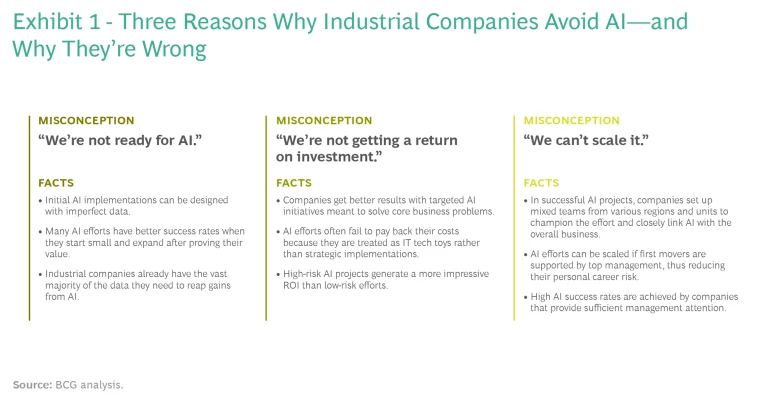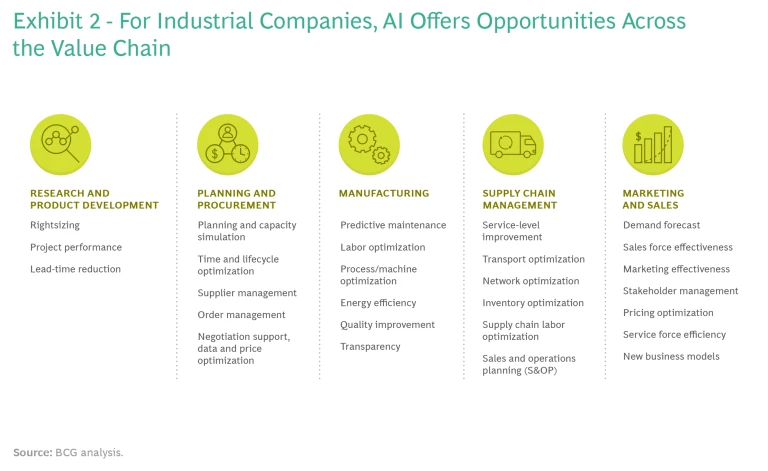When it comes to artificial intelligence (AI), there are essentially two kinds of industrial companies: those that have been hesitant to commit to AI programs, and those that have made significant investments only to come away dissatisfied with the results. Those in the second group are not alone. A 2020 MIT Sloan/BCG survey found that about 70% of companies in all sectors had piloted or deployed AI solutions; of these firms, only about 10% reported significant gains from AI projects.
For companies in the industrial sector—manufacturers of materials and heavy equipment, automotive OEMs and the like, and companies in subcategories like transport and logistics—this period of scattered and frustrating AI uptake might have continued for some time. But the pandemic has entirely changed the landscape . To remain profitable during what promises to be a long and unsteady global economic recovery, industrial companies will be looking to greatly increase efficiency, reduce operating expenses, and improve processes and products by speeding up operational digitization—including the adoption of advanced analytics and AI.
This is no secret to industry executives; in another recent BCG survey , 85% of industrial goods companies said that digital transformation will take on a greater urgency in the wake of the pandemic. With digitization efforts heating up among their competitors—and with the associated technologies advancing at a breakneck pace—industrial companies must act now on AI. But first, they need to understand why such efforts have failed in the past.
Taking a Second Look at AI
While a few industrial companies can aptly be termed AI success stories, they are rare. The BCG survey found that, among industrial firms, only 34% said their digital transformations —of which some form of AI is increasingly a critical element—met their goals.
The limited returns from AI may puzzle some industrial company executives, but there are logical reasons for it. Typically, AI initiatives have been led by technical specialists, experts focused on what they’re most passionate about: toying with the latest high-powered digital features. Business units, in turn, are too often asked to tailor their processes to newly developed AI applications, rather than having the applications created in tandem with users to address immediate business needs. In the process, the power that AI could bring to specific strategic efforts—where real value and growth potential reside—often becomes a secondary consideration.
The limited returns from AI may puzzle some industrial company executives, but there are logical reasons for it.
Not surprisingly, organizational resistance to AI is rife, and culture clashes increasingly separate the technical and business sides of companies—undermining AI’s potential for improving business processes and performance. Among the gains AI applications can offer are improvements in supply chain resilience using predictive models and end-to-end transparency; better manufacturing efficiency through factory automation and person/machine collaboration; enhanced product quality and features; more effective price-setting using customer data; and removing friction from customer interactions, to name a few.
To unlock these benefits, players in the industrial sector must overcome their own resistance to AI. We believe that three common misconceptions are hampering companies’ chances for successful AI applications. (See Exhibit 1.)
“We’re not ready for AI.” It’s easy to find reasons not to launch an artificial intelligence program. Some companies avoid AI because they mistakenly believe such an initiative has to be perfect from the start, accounting for all complexities and special cases—a large-scale, all-encompassing effort with no incremental steps. Others assume they don’t have enough data, or data of sufficient quality, to power AI; these companies worry that their factory sensors may not be distributed widely enough, or that they lack access to the kinds of external information needed to enable useful advanced analytics. And some companies fear their networks cannot handle a modern AI system.
These concerns are understandable, but they are overblown. Many of the best AI implementations start small, expanding further into the business as the application proves its value. As for data issues, in our experience industrial companies usually have large enough data assets to make a performance step change with AI in their corporate networks—although the data might not be easily accessible or coherently organized. Moreover, the process of developing an AI solution would help determine the required IT infrastructure and point out any shortcomings in data management and usage.
Meanwhile, there are huge drawbacks to putting off AI efforts. A company that chooses to wait for just the right moment to get started—until, for instance, leaders have all the data they think they need—will only fall further behind in digitization without having anything to show for it. That’s not an advantageous place to be, particularly when nearly half of the executives surveyed by MIT and BCG said they perceived risk to their business from AI.
A company that waits for the right moment to begin its AI efforts will only fall further behind.
This risk can come in many forms. First, other industrial companies could implement ambitious AI projects to gain a competitive edge over their traditional rivals. And second, more technologically oriented companies might use AI—for example, a machine learning system that can design and build with 3D printing customized parts for a variety of vehicles on the same assembly line based on customer preferences—to disrupt and enter industrial sectors.
In both instances, AI solutions would be used to overcome the technical knowhow and institutional knowledge of incumbent companies. Which means leading industrial players have an opportunity they might not immediately see: to pair their valuable technical expertise and their vast data assets with AI, and stay ahead of new and existing rivals over the long term.
“We’re not getting a return on investment.” Industrial companies that have made previous investments in AI raise different concerns. Among the most common is that their investments in machine learning and advanced analytics often fail to generate an obvious payback. According to the MIT Sloan/BCG survey, companies that could be termed AI pioneers—the businesses that are most advanced in their adoption and commitment to AI—are frequently underwhelmed by the ROI.
When returns are lacking, the problem frequently is that the company has many AI initiatives underway but none of them is sufficiently robust or mature, and none is linked to improving a clearly identified business operation. In other words, these AI projects are seen as experimental technology toys that may have some impact in the future, as opposed to serious strategic pillars intrinsic to the company’s success. In the end, such programs are fated to be disappointing—developed as orphans, with minimal appeal and viability.
It doesn’t have to be this way. Indeed, our survey found that half of all companies investing in high-risk AI projects have received real value in return, compared with only 25% of those investing in low-risk efforts. For example, a chemical company we worked with was hurt by extremely high customer churn—as much as 15% each year—which took a significant toll on EBITDA. After implementing an AI system that focused on identifying customers that were likely to go elsewhere—and, in turn, creating customized retention and upselling programs to expand the revenue stream—churn was reduced by nearly 50%.
“We can’t scale it.” Another frequent complaint about AI from industrial companies is that even the most successful programs are difficult to scale to other regions or products. This concern isn’t entirely unfounded—there is, in fact, a “first-mover” disadvantage with AI. Markets differ greatly, from customer preferences to the local regulations a company must adhere to; as a result, an AI system cannot simply be transferred from one locale or another. Furthermore, each AI installation in a new region requires extracting and cleaning local data and addressing unique local idiosyncrasies. Many organizations therefore prefer to hold off, hoping another unit in their region will take the plunge first.
Some regional managers also feel threatened by the prospect of scaling an AI program. Since they usually don’t understand the program’s intricacies, managers often feel they cannot control its success or failure. This fear is only amplified if the program is operating well in some other region; if it doesn’t produce results locally, the manager could be blamed. The heads of AI teams, meanwhile, are typically unable to put these managers at ease because they tend to be younger and technocentric—and, all too frequently, they show little knowledge about how the business side and the potential users of the program operate.
Finally, organizational culture often dictates against scaling an AI program. Scaling is never easy, even when it comes to projects less complex than AI. Many companies do not have the appropriate capabilities and the internal talent to smoothly distribute a sophisticated technology across its regions.
Limited AI efforts can be a proving ground for projects that can later be adapted for use throughout an organization.
Still, these issues can be overcome if management backs the AI effort as a critical strategic goal and earmarks sufficient resources for the project—including the recruitment and development of talent suited to an AI-focused organization. In addition, regional managers should be assured that they won’t be penalized for any short-term hiccups in performance that may occur while incorporating the new technology.
Five Ways to Facilitate AI Adoption
The challenges industrial companies face when implementing an artificial intelligence solution are real, but they are largely self-imposed. By approaching AI with the right mindset—and with the needed capabilities and talent—players can ensure benefits across the industrial goods value chain. (See Exhibit 2.)
To that end, here are five imperatives for companies looking to fix their AI engines.
Put strategy first, AI next. Successful AI implementations directly support the business’s overall goals and strategies. They begin as an operational solution, not a technological advance initiated by data scientists. Industrial company executives should ask themselves, “What are the essential value drivers at my company, and what are the pain points standing in the way of generating more value? What are the key business decisions we make, and how could we improve them?”
In answering those questions, the focus of a company’s initial AI applications—whether locations, operations, functions, processes, or decision-making procedures—should become apparent. This doesn’t have to be a complicated or long-term effort. More than likely, the first candidates for AI solutions are also the parts of the business that are already in need of digital transformation. Simply put, look backward from strategy, not forward from AI—and always keep the business at the center of the initiative. AI outcomes must have a direct and unambiguous link to how they will create value and improve KPIs.
A logistics operator showed the benefit of this approach when it spent the first months of its AI initiative studying all the possible artificial intelligence applications in its organization. The company then clustered these programs into groups, evaluating each by its value potential, its feasibility, and its likely contribution to overall company strategy. Following that, pilot efforts were launched and the most promising AI programs were subsequently scaled across the organization. This stepwise plan succeeded in a way that a random approach would have failed.
Start simple. After you have identified the parts of the value chain that can get the most leverage from an AI implementation, new algorithms should be designed, developed, and installed in bite-size doses. Initial small victories are a powerful way to slowly inculcate the value of AI into the culture of the organization.
And in truth, there really is no other option besides starting with the basics. Collecting, analyzing, and networking the data that will form the core of an AI program is a critical and arduous step—and it can be done only in a slow, disciplined fashion.
To build an AI system, a company needs to define the data it collects, identify how and in what form that data is generated, and then determine which data is useful. This is made more difficult by the fact that, as we have observed, most company databases have fields that are incomprehensible to virtually everyone—fields so old, in some cases, that no one remembers how the data was calculated or what it was used for.
Still, if your initial AI projects are limited enough, data transparency should not impede getting a project up and running relatively quickly. Nascent and limited AI efforts can be a proving ground for projects that later can be adapted to address analogous problems across an organization. This is particularly true of complex data analysis—classifying and extracting information from unstructured documents, for example—that can be handled through natural language processing on a small scale before implementing the same program in multiple departments.
Consider 70/20/10 the new 80/20. It is a well-worn business concept that 80% of a company’s sales come from 20% of its customers. A good rule of thumb for an AI project, meanwhile, is that success depends 70% on business, people, and processes, 20% on technology, and 10% on the algorithm. This ratio ensures that data science solutions are anchored in the business and driven by it. Moreover, these proportions encourage business unit managers and process owners in the organization to embrace an AI solution—because it has been designed to deliver on key performance metrics.
AI initiatives should focus on solving a core business problem.
To apply these proportions, companies should create multidisciplinary teams of business-side leaders and data scientists. Together they can ensure that any AI effort has a strong focus on generating value and ROI, and solves a core business problem. Only then should a company turn its attention to producing a fancy, full-fledged software solution. Using the 70/20/10 ratio, companies that have a variety of small AI proof-of-concept campaigns underway can pare back their raft of initiatives to concentrate on the ones that can have a meaningful impact on the business. To ensure satisfactory ROI, benchmarks should be devised to closely monitor the success of the initial portfolio of AI projects—and development teams should be prepared to change course as needed to further improve returns.
The 70/20/10 ratio has generated numerous success stories, including the digital transformation of a large B2B power equipment distributor. While multiple state-of-the-art, proprietary AI algorithms were developed, the algorithms and technology were only a small part of the overall effort; business leaders, as well as newly recruited sales staffs, championed the new AI program and supported its continuing evolution. The program is now deployed in eight countries—used in supply chain, pricing, inventory, customer interactions, and demand forecasting.
Foster a startup culture. Another significant, but often overlooked, benefit of adopting AI in small amounts is that it can propel a culture of entrepreneurialism and experimentation. Rather than developing the technology through a large data science or IT department, AI programs can be initiated by agile teams working with individual business units. These teams could be assigned to come up with new ideas for machine intelligence that would improve operations in their units and that could potentially be scaled across the business.
Such teams should be allowed to experiment and not be punished for temporary failures. (In the world of agile software development, this idea is better known as fail fast, fail cheap, learn fast.) And the teams should be given the privilege of short decision cycles and the authority to make necessary changes in the AI program on the fly rather than being burdened by corporate bureaucracy, which can slow innovation to a crawl. Even with the best intentions, innovation units can fail if lengthy and risk-averse decision-making processes on the business side are not relaxed.
This was nearly the case at a leading automotive OEM. The company created a data science team with the authority to develop new AI-based and data-driven ideas as they saw fit and as their creativity allowed. Many proof-of-concept programs followed, but the team was stymied by a lack of interest from the rest of the organization. Only after the OEM implemented data-science governance policies, which aligned the goals of the data team with the strategic evolution of the organization, did the team’s output gain traction elsewhere in the company and generate value for the overall business.
Be a champion for change. At many industrial companies, AI implementations in individual business units are thwarted by local management resistance. To overcome this resistance and encourage flexible change-management attitudes and actions, senior corporate management must frequently broadcast its support for AI projects. Company leaders should emphasize that AI has broad applicability across the organization, and that it is an essential part of the digitization efforts that are necessary to survive in a difficult industrial environment.
They should counter the concerns of unit managers by stressing that, in the new “fail fast” culture, no one will be blamed if an AI project runs into glitches, and that applications will be customized around the needs of individual business units. Above all, they should communicate that local management will be fully involved throughout the development process, and that the managers themselves have the chance to be innovation leaders in the organization.
Indeed, many of the best AI implementations in the industrial sector are due to change agents within the organization—unit managers who engaged with data scientists as the application was built, challenging them and making demands based on local user needs and business unit expectations. And after the AI solution was in full swing, they became ambassadors for the technology, championing it to their peers in other regions, business units, and sites.
A Fresh Start for AI
Between the upheavals to global business caused by COVID-19 and the rapid evolution of AI technologies—not to mention the renewed digitization efforts of their competitors—the time has come for industrial companies to rethink their misconceptions about artificial intelligence. After a long period of AI initiatives that were by and large disappointing, industrial businesses have the chance to do it right, using our five imperatives as a roadmap for exiting the crisis stronger than they were before.













